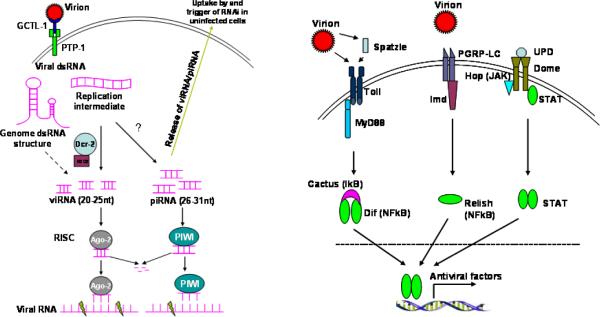Figure 1.
Proposed anti-WNV signaling pathways in mosquitoes. There is very little information on WNV-mosquito interactions. The model is drawn based on known antiviral pathways in Drosophila and Anopheles. a) siRNA-mediated antiviral signaling. Extracellular WNV virions are recognized by a secreted C-type lectin, mosGCTL-1, which then interacts with a cell surface membrane-bound protein tyrosine phosphatase homologue, mosPTP-1, to enable receptor-mediated endocytosis of virions. The dsRNA structures of viral genome or dsRNA intermediates resulted from replication are processed by RNase III, Dcr-2, into 20–25 nt long viRNAs. viRNAs are then integrated into RISC complex containing Ago-2 and several other proteins. One strand of viRNA is then degraded, the remainder is targeted to a complementary viral RNA, which is subsequently cleaved by RISC clipper Ago-2. piRNA-mediated RNAi is less understood, but could resemble viRNA. Free siRNAs or viral RNA released by secretory transport or lysis of infected cells could be internalized by uninfected cells, stimulating an antiviral state. b) Toll, Imd and Jak-STAT antiviral pathways. Virions can be directly sensed by Toll receptors or viral infection and can activate a serine protease cascade, leading to activation of Spatzle, a Toll ligand. Engagement of Toll leads to MyD88-dependent signaling cascade and eventually NF-κB mediated-transcriptional induction of numerous antiviral factors. Similarly, virus (glycosylated envelope proteins?) acting via peptidoglycan recognition protein (PGRP) or other unknown receptors, may activate Imd-dependent antiviral gene induction. The Jak-STAT pathway is initiated by the binding of Unpaired (UPD) to its transmembrane receptor, Domeless (Dome), which is then phosphorylated by Hopscotch (Hop). Subsequent phosphorylation, dimerization and nuclear translocation of STAT activates antiviral gene expression.

